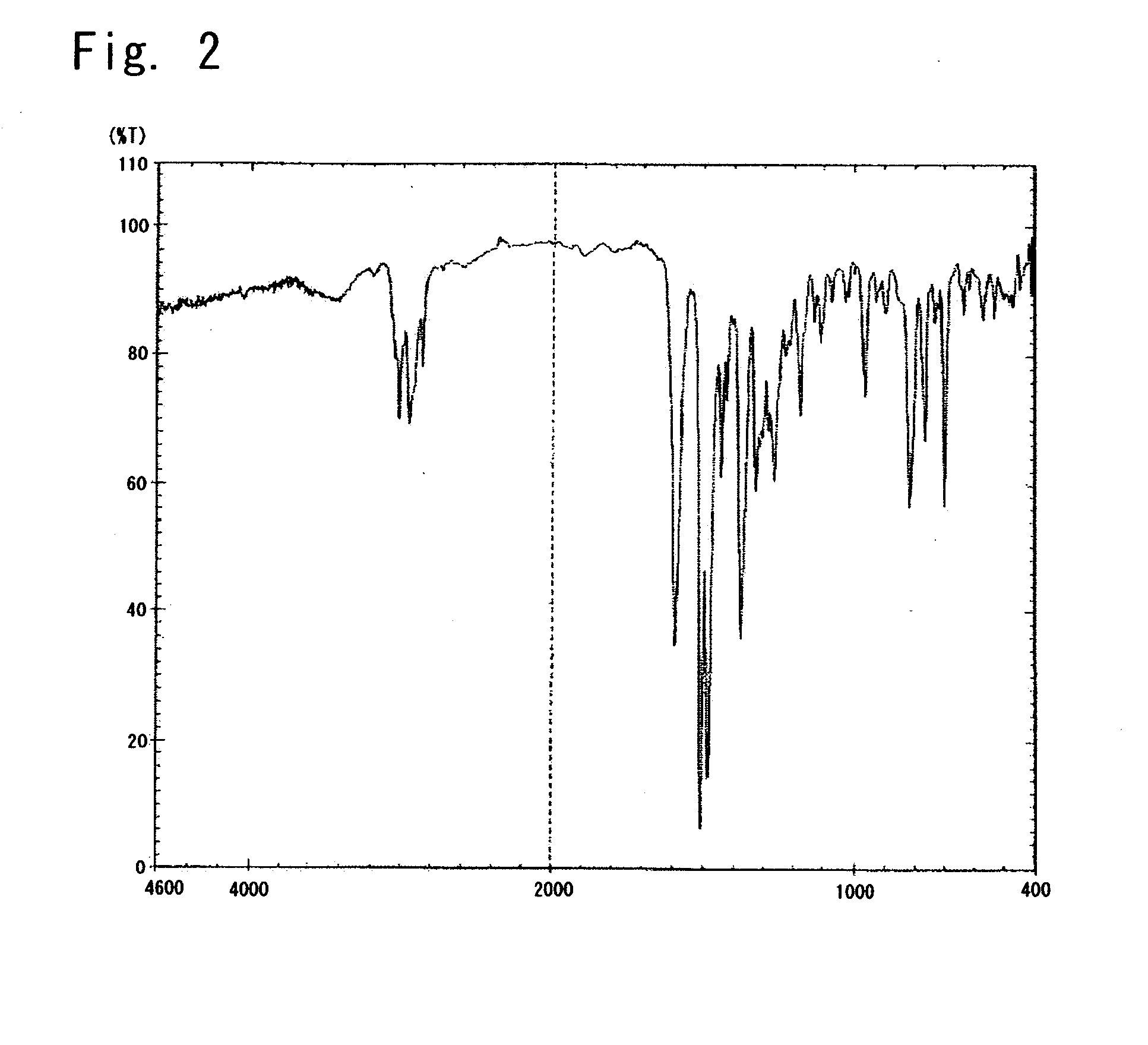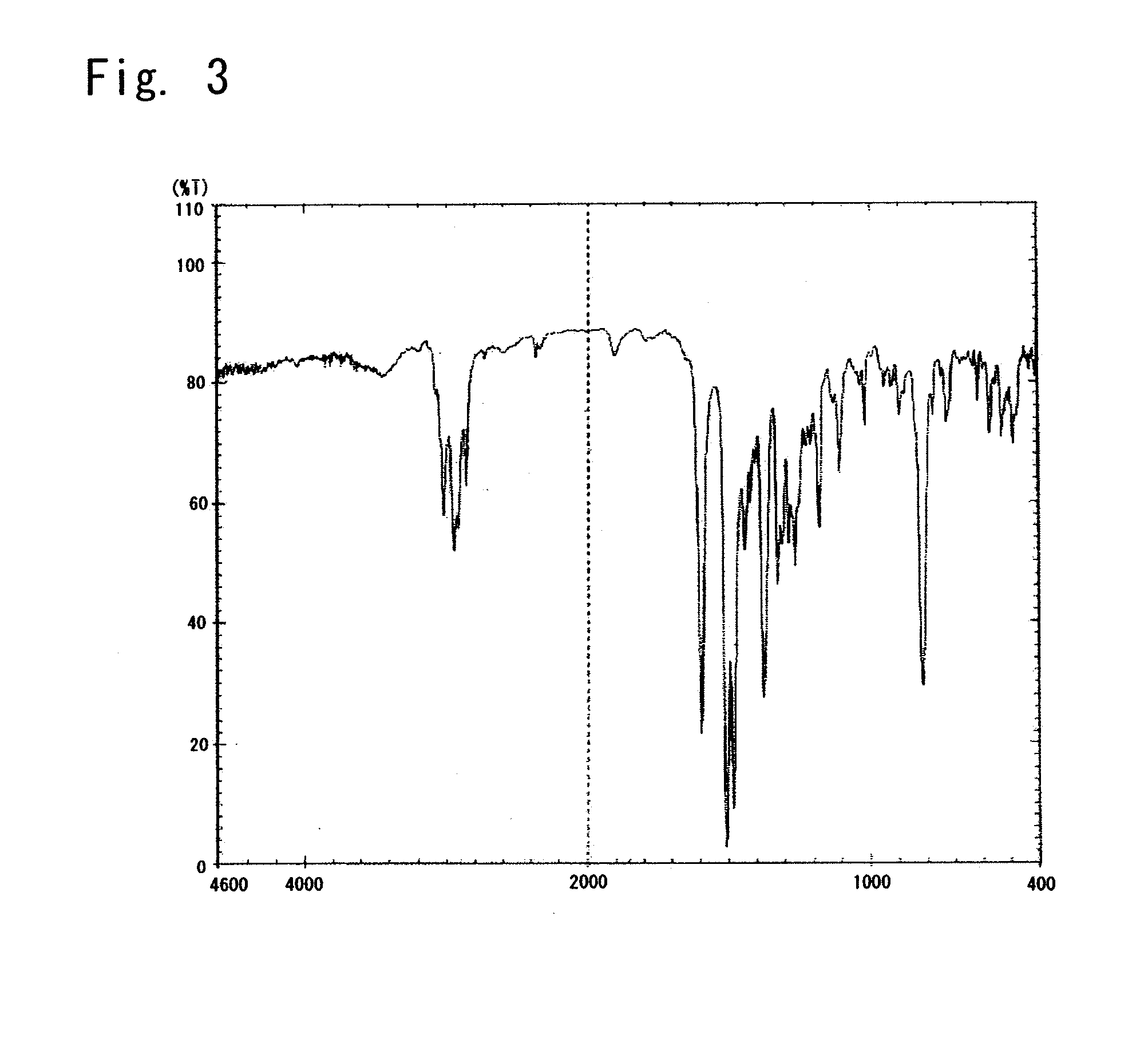Indole derivatives
a technology of derivatives and indoles, applied in the field of indoles, can solve the problems of poor resistance of selenium, poor resistance of oxides to moisture, poor resistance of zinc oxides to printing, etc., and achieve the effects of low residual potential, high carrier mobility, and high sensitivity
- Summary
- Abstract
- Description
- Claims
- Application Information
AI Technical Summary
Benefits of technology
Problems solved by technology
Method used
Image
Examples
synthesis example 1
Synthesis of an Example Compound 4
[0327]An N-phenyl-substituted indole compound represented by the following formula (15) was prepared as a starting material. This compound was a known compound disclosed in the patent document 16.
[0328]Into a reaction container were introduced 15 g of the above N-phenyl-substituted indole compound, 4.5 g of an N,N-dimethylformamide and 8 g of toluene, and to which was added 9 g of a phosphoryl trichloride dropwise. While heating, the mixture was stirred at 80° C. for 3 hours. After left to cool, 8 g of water was added thereto dropwise while being cooled, followed by the addition of sodium carbonate to render the reaction solution to be alkaline.
[0329]Next, the solution was heated at 60° C. for 3 hours and was, thereafter, extracted with toluene. The extract was washed with water and next with saturated brine and was, thereafter, dried on magnesium sulfate. Upon distilling off the solvent, there was obtained 14.4 g of a yellow solid formyl compound r...
synthesis example 2
Synthesis of an Example Compound 5
[0334]4 Grams of the formyl compound of the above structural formula (16) obtained in Synthesis Example 1 and 10.5 g of a ditolylmethyl phosphorous acid diethyl ester were dissolved in 50 ml of the N,N-dimethylformamide, and to which was added 1.7 g of the sodium methylate while maintaining the temperature at 20±5° C. After stirred for 2 hours, 30 ml of ion-exchanged water was added thereto, and the mixture was refined in a customary manner to obtain 2.8 g of a compound represented by the following formula (18) (yield, 51%).
[0335]This compound was a yellow solid and corresponded to the above example compound 5.
[0336]Through the elemental analysis and IR measurement, it was confirmed that the above yellow solid was a compound represented by the above formula (18). The IR spectrum thereof was as shown in FIG. 2.
[0337]Values of the elemental analysis were as follows:
CarbonHydrogenNitrogenMeasured (%)90.897.022.09Calculated (%)90.847.002.16
synthesis example 3
Synthesis of an Example Compound 22
[0338]4 Grams of the formyl compound of the above structural formula (16) obtained in Example 1 and 10.4 g of a diphenylpropylene phosphorus acid diethyl ester were dissolved in 50 ml of the N,N-dimethylformamide, and to which was added 1.8 g of the sodium methylate while maintaining the temperature at 20±5° C. After stirred for 2 hours, 30 ml of ion-exchanged water was added thereto, and the mixture was refined in a customary manner to obtain 3.3 g of a compound represented by the following formula (19) (yield, 600).
[0339]This compound was a yellow solid and corresponded to the above example compound 22.
[0340]Through the elemental analysis and IR measurement, it was confirmed that the above yellow solid was a compound represented by the above formula (19). The IR spectrum thereof was as shown in FIG. 3.
[0341]Values of the elemental analysis were as follows:
CarbonHydrogenNitrogenMeasured (%)91.156.742.11Calculated (%)91.126.712.17
Photosensitive Mat...
PUM
| Property | Measurement | Unit |
|---|---|---|
| aromatic | aaaaa | aaaaa |
| charge transporting | aaaaa | aaaaa |
| photosensitive | aaaaa | aaaaa |
Abstract
Description
Claims
Application Information
 Login to View More
Login to View More - R&D
- Intellectual Property
- Life Sciences
- Materials
- Tech Scout
- Unparalleled Data Quality
- Higher Quality Content
- 60% Fewer Hallucinations
Browse by: Latest US Patents, China's latest patents, Technical Efficacy Thesaurus, Application Domain, Technology Topic, Popular Technical Reports.
© 2025 PatSnap. All rights reserved.Legal|Privacy policy|Modern Slavery Act Transparency Statement|Sitemap|About US| Contact US: help@patsnap.com



